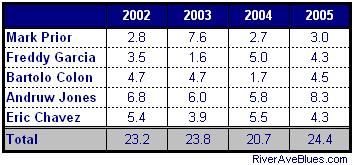Even before last night’s third deck shot, Andruw Jones had gone from dud to legitimate force for the Yankees in the second half. I wrote about his improvement earlier this week, and as it turns out, the outfielder had some help with the turn around. “My mom called me and told me look at your old tape,” said Jones to Jack Curry. So he watched some old tape of him from last year (.364 wOBA overall, .402 vs. LHP) and widened his stance, which helped him feel more comfortable at the dish. Andruw’s mom is cool with me.
The Andruw Jones Revival

Andruw Jones made a pretty good first impression on Yankees’ fans. His first plate appearances of the season resulted in six pitch at-bat and a solo homer off Twins lefty Brian Duensing, exactly the kind of pitcher he was brought in to mash. Andruw had four hits in his first four games (three starts and 11 plate appearances), including a double and the homer, so everyone was happy. Unfortunately the good times stopped there, at least for a while.
Jones’ bat went silent after that, with April 27th and May 25th (two dingers) representing his only other multi-hit games in the first half. He went into the All-Star break with a .195/.278/.356 batting line in 97 plate appearances, hitting just .231/.315/.446 in 73 PA against lefties. Forty-one days had passed since his last extra base hit when the Yankees parted ways for the break, and he had been hitless in his ten previous at-bats before the midseason vacation. Considering how massively productive (126 wRC+) and likable the guy he is replacing (Marcus Thames) was in 2010, the majority of the fan base was decidedly anti-Andruw come mid-July.
Since the All-Star break, it’s been a much different story for Mr. Jones. He started the first game of the second half against the Blue Jays and lefty Jo-Jo Reyes, and he responded with two homeruns. Two days later he started against Ricky Romero and singled in the tying run in the eventual win. Gio Gonzalez was met with two RBI singles a few days later, and a couple days after that it was Zach Britton feeling the wrath of an RBI double and Jason Berken getting taken deep for a solo shot. Andruw came back from the break like a man possessed, hitting everything in sight and he hasn’t stopped since.
In 46 second break plate appearances, Andruw’s hitting .342/.457/.632 overall and .370/.485/.667 against lefties. Of course it’s a small sample size, we’re not trying to determine if this pace is sustainable (hint: it’s not), we’re just acknowledging that Jones was able to shake off the poor first half and make some noise heading into the dog days of summer. His season batting line has been boosted to .240/.336/.440, better than his preseason ZiPS projection (.221/.320/.438). He’s getting on base (.368 OBP) and hitting for way more power (.239 ISO) in 106 PA against lefties than Thames did last year (.352 OBP and .154 ISO) in 142 PA. Andruw’s also hitting .343/.410/.543 with runners in scoring position, for those inclined to value those situations.
The season hasn’t gone exactly according to plan for the Yankees fourth outfielder, but a scorching hot start to the second half has helped offset his awful first half. Jones is at the point where he’s doing what’s expected of him, and that’s get on base and hit for a ton of power against lefties despite a low batting average while playing something better than awful defense. It’s a thankless job for a guy that once ran off four 7+ fWAR seasons in a five year stretch and owns 400+ career homers, but Jones is contributing to the Yankees cause and has been better than expected since the All-Star break.
The new designated hitter platoon
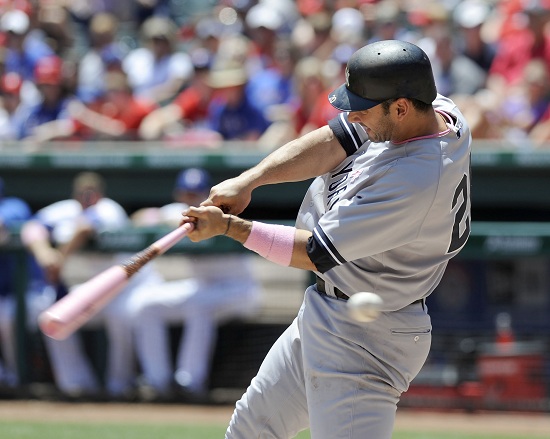
Jorge Posada is out. Before last night’s game the Yankees informed Posada of his new role off the bench, paving way for a DH platoon that will involve Eric Chavez and Andruw Jones for the time being. As Mike noted this morning, that leaves the Yankees bench fairly inflexible, especially since it’s only three men deep to begin with. That’s certainly one downside to the issue. But what about the other side? Will the Jones-Chavez tandem significantly outperform Posada for the rest of the season?
Updated projections can give us one sense of expected production. ZiPS updates its numbers constantly, adjusting its full-season and rest-of-season projections as the season progresses. This helps weed out some of the noise we get in partial-season samples. It’s quite optimistic about the final two months of Posada’s 2011, projecting him for a .334 wOBA in 126 PA. That amounts to about two runs above average, though that is below average production for a DH. That projection might seem overly optimistic, since Posada has produced a mere .299 wOBA to date. But he has produced much better against righties, a .341 wOBA (5.1 runs above average). There is a chance, then, that he could hit that .334 projection if given 126 PA exclusively against righties.

Taking over his role as the DH against righties is Eric Chavez. A foot injury has limited him to just 26 games and 76 PA this year, but he’s done a fine job filling in, producing a .368 OBP and a .336 wOBA. ZiPS has him on track for just 36 more PA this season at a .300 wOBA, which would mean below average production. The upshot here is that his ZiPS projection is based on the past few years, in which he played hurt and hardly played in general. There is reason to believe that he’ll beat that production if he remains healthy. Unfortunately, Chavez is a risk to get hurt at any point, making his projection even more difficult. It’s as easy to see him matching Jorge’s .334 projected wOBA the rest of the way as it is to see him produce nothing while on the DL.
For most of the season Jones has played the part of DH against lefties, though as I’ll describe in a moment it hasn’t always been a straight DH role. He’s apparently hitting right in line with his ZiPS projections: his .341 wOBA matches his rest-of-season and full-season projection. At his 87 projected plate appearances the rest of the way, that would work out to 1.9 runs above average. That makes for a decent right-handed part of the platoon, though again it’s not above average for a DH. The caveat is that with that kind of playing time, a couple of extra strikeouts could significantly downgrade his production, just as an extra homer can significantly upgrade it.
Given the projections it would appear that the former platoon of Posada and Jones would work out best. Chavez fits, because he’s hit this season and is expected to continue his current pace, rather than his projected one. But even then, the Yankees are looking at about four runs above average for their DH spot the rest of the season. With that kind of production, combined with the inflexibility that the arrangement causes, should give the Yankees pause. That might work as a quick-term fix, and if Chavez breaks out while getting regular playing time it might stick for a bit longer. But I suspect that this is merely a tide-over while the Yankees let the effects of the Posada benching dissipate.
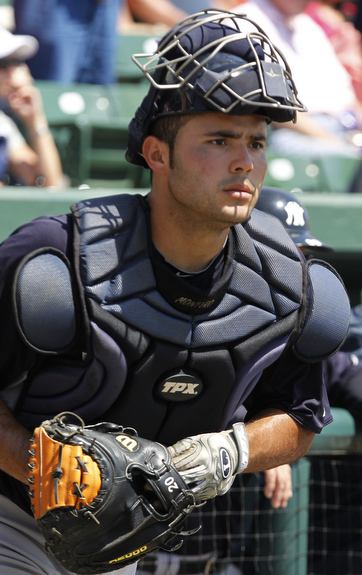
When the Yankees announced Jorge’s benching, the one name on everyone’s tongue was Jesus Montero. There has been talk of his promotion for weeks, and with Posada on the bench there appears to be a clear opening. There’s a chance that Chavez and Jones are merely a placeholder so that the Yankees don’t have to bring up Montero as Posada’s replacement, which would create additional and unnecessary tension and drama. Bringing him up to replace the Chavez/Jones platoon might be a bit easier for the organization to handle, though they could be losing out on potential production.
ZiPS projected Montero to produce a .358 wOBA in the 2011 season, a mark greater than any of the current DHs. If we project Montero to get 200 PA the rest of the way — which is in line with Robbie Cano’s projected remainder — he would produce 7.3 runs above average. That’s nearly double what the platoon would combine to produce. It’s tough, of course, to project a rookie to produce at that kind of level, especially when he hasn’t even produced that well at AAA. But we know what type of talent Montero possesses, and we know he can go on a tear. If he goes on one with the Yanks, he’ll easily be their best DH option the rest of the way.
This DH platoon does afford the Yankees a bit of flexibility, especially after Alex Rodriguez returns from the DL. It will allow Joe Girardi to cycle through his players who might need a half day off, using them as DH and either Jones or Chavez in the field. That stands in contrast to Jorge, who can spell only Mark Teixeira at first. Chavez can do that, as well as handle A-Rod’s duties at third, while Jones can take over for any of the three outfielders (with Gardner going to center when Granderson gets a day). That should help keep everyone fresh as the Yanks play 30 games in 30 days, including a doubleheader.
While the new DH platoon does pose some risks, it does provide a number of benefits. Chavez, while not projected to hit well, has produced while healthy. Posada has actually produced similar numbers as a left-handed hitter this season, but apparently the Yankees feel that Chavez is the better bet going forward. The gained flexibility is also a major benefit, since the Yankees are rather inflexible as currently constructed. The plan comes with a ready made backup, too, as Montero can slide into that spot if it becomes necessary. This move probably won’t pull the Yankees out of the bottom half of the league in DH production, but it figures to be something of an improvement over the current arrangement.
About that 2003 stuff…
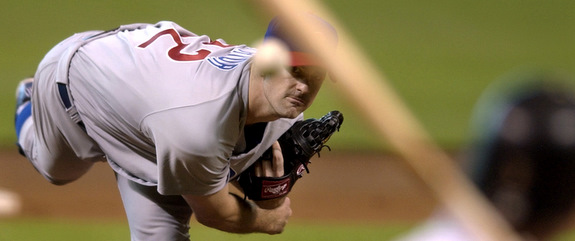
Once the Yankees failed to sign Cliff Lee, they shifted into salvage mode and grabbed what they deemed to be useful players on the cheap. Among that group was fifth starter Freddy Garcia, long man Bartolo Colon, bench players Andruw Jones and Eric Chavez, and reliever Mark Prior. As each signing trickled in, a familiar wisecrack was bestowed from the masses: “they’d win if it was 2003!” The joke came in various forms, but the one constant was 2003 for whatever reason. People were fixated on that year. So, naturally, the question becomes: what’s so special about 2003 anyway?
2002
This is a convenient place to start since it’s Prior’s first (half) year in the bigs. He came up in late May and pitched to a 3.16 FIP in 116.2 IP, striking out 11.3 batters per nine. Colon was in the middle of a six-year stretch of 4-5 fWAR seasons, splitting a 3.73 FIP in 233.1 IP between the Indians and Expos. Sweaty Freddy was already a vet at age 25, with 87 big league starts to his credit. His second straight Opening Day assignment was followed by 223.2 IP of 4.01 FIP pitching. That’s a fine three-man pitching staff right there.
Jones’ .377 wOBA was the second highest of his career at the time, and the 15.6 runs he saved on defense (!) was then the lowest full season total of his career (!!) by eight runs (!!!). Chavez was a young buck just coming into his own at the time (24 years old), but his .364 wOBA was his third straight year in the .360’s. He also saved nine runs with the glove, down four from the year before.
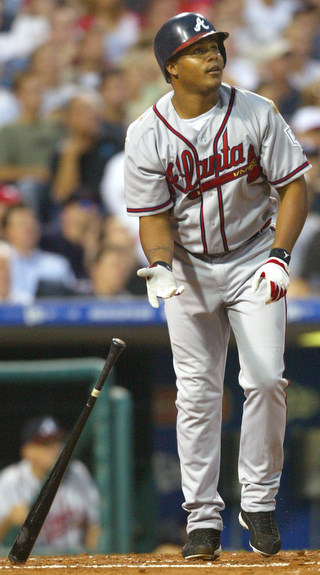
2003
Prior zoomed right past Beast Mode and went straight into F*ck Sh*t Up Mode this season, giving the Cubbies 211.1 IP with a 2.47 FIP. Over the last eight years, there have been only five instances in which a pitcher has posted a FIP that low in a single season (min. 180 IP). He was, as they say, redonkulous. Garcia had one of the worst full seasons of his career with a 4.82 FIP in 201.1 IP, and Colon was rather ordinary with a 4.11 IP in a crazy 242 IP. That’s the sixth most innings thrown in a single season by a non-Roy Halladay pitcher over the last eight years. Jones had another phenomenal year (.361 wOBA, 18.4 runs saved) but Chavez slumped with the glove, costing his team 5.2 runs defensively. He did provide another .360-ish wOBA (.365 to be exact), the fourth straight year. This is the year everyone keeps referring too, though Prior and Jones were the only real standouts.
2004
Things started to go south for Prior in ’04, but he still managed a 3.53 FIP in 118.2 IP. Colon had the worst full season of his career (4.97 FIP in 208.1 IP), but Garcia had the second best of his career (3.67 FIP in 210 IP). Once again, Andruw was a monster, saving 24.3 runs defensively with a .351 wOBA. That’s his worst offensive performance in this here “study.” Chavez, meanwhile, had the best offensive season of his career thanks to a .383 wOBA, and he also saved eight-and-a-half runs at the hot corner. The Prior injury and Colon’s poor season really drag this group down.
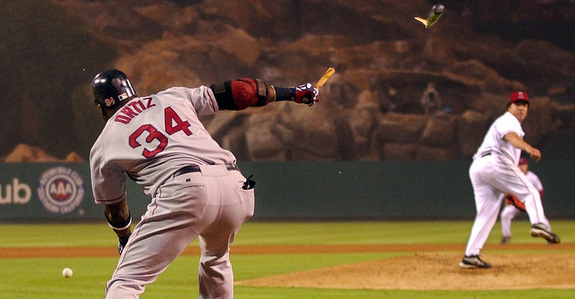
2005
Jones stole the show this season, clubbing 51 homers and registered a .382 wOBA at age 28. He also saved 24.3 runs in center, resulting in an 8.3 fWAR effort that was second only to some guy named Alex among all position players. Colon won the Cy Young this year, but a 3.75 FIP in 222.2 IP is more really good than Cy worthy. Garcia (4.05 FIP in 228 IP) and Chavez (.342 wOBA, 7.1 runs saved) were solid but not brilliant. The ’05 season was Prior’s last hurrah, a 3.85 FIP in 166.2 IP. He made nine appearances in 2006 and hasn’t been back to the show since.
* * *
Now that we have an idea of what each player did during this completely arbitrary four year stretch, let’s recap it all using everyone’s favorite catch-all stat, fWAR…
While this fivesome did some fine work in 2003, the 2005 season is where it’s really at. Each player was worth at least three wins, and four topped at least 4.3 wins. The star-level performances aren’t there after Jones, but one star and four other above-average contributors is a recipe for success. So the next time someone says the Yankees would be doing great if it was 2003, make sure you point out that they’d be doing even better if it was 2005.
Is Andruw Jones really a lefty masher?

Aside from starting pitching, the Yankees had just a few glaring needs this offseason. The most obvious of the bunch was the need for a right-handed hitting outfielder to give Joe Girardi some flexibility and thump against left-handed starters. Marcus Thames did the job perfectly last season, tagging lefties for a .354 wOBA and even chipping in far more than expected against righties (.382 wOBA). As well as he performed, it was Thames’ best offensive season in five years, an effort he was unlikely to repeat at age 34. Given his defensive shortcomings, it was easy for the Yankees to move on. That led them to Andruw Jones.
Jones, the guy that tormented Yankees fans back in 1996, fit the job description perfectly. He’s a right-handed bat with power and he can play some defense. No, he’s not the all-World defender he was in his prime, but he’s considerably better than Thames and probably closer to average more than anything. Add in his low cost ($2M) and long track record, and there are plenty of reasons to like the move. But is he really all he’s cracked up to be offensively?
The Yankees brought Jones in the hit left-handed pitching and that’s exactly what he did last year, when he tattooed southpaws to the tune of a .402 wOBA. Unfortunately, that’s in an incredibly small sample size, just 102 plate appearances. If you take out his 2008 season, when a knee injury kept him on the disabled list for close to three months, it’s his fewest attempts against lefties since 2002. In 2007 and 2009, when Andruw’s career really started to slip, he put a .336 wOBA in 368 plate appearances against left-handers (it was .289 in 86 PA in 2008). Granted, that’s still respectable, but it’s hardly jaw-dropping.

If you go back a little further, to Jones’ monster seasons in Atlanta (2004-2006), he had a .373 wOBA against lefties (473 PA), which is obviously outstanding. Unfortunately that was a baseball lifetime ago, when he was still in his mid-to-late 20’s and in the prime of a borderline Hall of Fame career. There’s little reason is expect Jones to repeat that effort going forward, into his mid-30’s. So what we have a bunch of wildly divergent data, each with it’s own red flag. Last year’s performance didn’t come over an extended period of time, but was it really a rebound from the three prior years in the career toilet? The stuff he did with Atlanta happened too long ago for it to mean anything today. There’s no reliable recent track record here, so that makes it a gamble.
And just to be clear, his awful Spring Training performance (.171.261/.293 in 46 PA before yesterday’s 1-for-3) means little to me. Thames had an awful spring last season and I ended up writing a very similar article about him, rather foolishly when I look back at it. Jones’ track record as a guy capable of giving the Yankees what the need – someone to pounded lefties – isn’t very good in the recent past when you look past last year’s small sample size results. I guess the good news is that the Yankees have alternatives this year, namely in the form of Justin Maxwell. Thames’ primary competition last year was Jamie Hoffmann, who ended up back with the Dodgers before the spring ended. At least Maxwell will be stashed in Triple-A to provide actual insurance.
It’s pretty clear that the Yankees did well by not bringing Thames back, and Jones was one of the best options on the market given their specific needs. That said, he’s no guarantee to give them what they’re looking for, but at least he’ll still be able to provide some value with his defense and occasional homers.
2011 Season Preview: Quality of the bench
One issue that plagued the Yankees through the mid-00s was the lack of a quality bench. This included both the position players and the bullpen. Both units tended to be sub-par. As we covered last week in our 2011 season preview, the bullpen looks a lot better, in terms of Opening Day personnel, than it has in many years. The bench, too, has a stronger feel this year. With plenty of spare payroll, the Yankees were able to land a few chips that they haven’t sought in years past. For the first time in a long time they’ll have two quality bench bats to start the year.
Andruw Jones
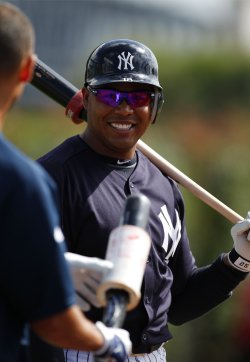
For most of the off-season, Jones and the Yankees appeared a natural match. They needed a fourth-outfielder, preferably a righty, and Jones needed a part-time destination. It took a while for the move to finally happen, and even longer for it to become official, but Jones is in a Yankee uniform for 2011. He’s not the same player that ranked among the most valuable in center field from 1998 through 2005, but he can still play a useful role.
For the past three seasons Jones has been a part-time player, either because of injury or ineffectiveness. Right knee problems completely sapped his 2008 season. In 2009 he appeared to be on the comeback trail, but fell off considerably after a hot start. Last year, with the White Sox, he started similarly hot, and while he dropped off it was not nearly as dramatic. At season’s end he had produced a .364 wOBA in 328 PA. The Yankees will gladly take that from him in 2011.
Not only can Jones provide some value with the bat, but his defense can still come in handy. He’s no longer the best-in-league center fielder, but he can fill in there if needed. More likely he’ll play left field against tough lefties, relegating either Brett Gardner or Curtis Granderson to the bench. This is a level of versatility the Yankees did not have in Marcus Thames.
Eric Chavez
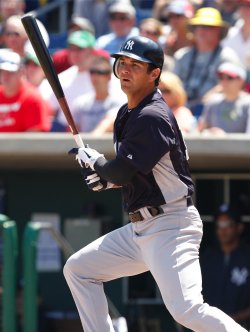
When the Yankees signed Eric Chavez to a minor league deal just before the start of spring training, it appeared to be an insignificant move. After all, Chavez hadn’t gotten as many as 300 plate appearances since 2007, and has been generally awful since 2006. Even then, since 2004, when he was limited to 125 games due to injury, he hasn’t measured up to the lofty standards he set in the preceding five seasons. But at age 33 there’s still potential. The Yanks, as it turns out, were right to jump on it.
In Chavez the Yankees have a player who can back up both Mark Teixeira and Alex Rodriguez. If Jorge Posada hits the DL for the fourth straight year, he and Jones can platoon at DH. He also provides a lefty off the bench, which can prove useful in late-game situations. The need for a lefty off the bench last year wasn’t great, since there weren’t many players for whom Girardi would pinch hit. But with Russell Martin on the team, and with the repeated possibility of guys such as Kevin Russo getting playing time, having Chavez’s bat in late innings will help plenty.
While spring stats mean little, Chavez has impressed during his time this March. Even when he makes outs he’s hitting the ball hard. He will certainly travel north with the team, with the hope that a part-time role will help keep him healthy and productive. It might not be striking gold, but the Yankees have done very well for minimal risk.
Ramiro Pena / Eduardo Nunez
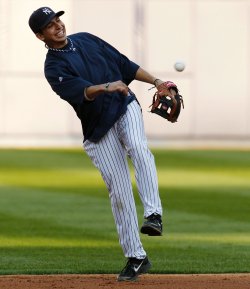
It just feels as though the Yankees want Nunez to fill that utility infield role. In recent games they’ve tried him in the outfield, a sign that they’re grooming him for a super utility role. It hasn’t appeared pretty, though, and chances are Nunez will stick to the infield, at least in 2011. But will he play behind Jeter, Rodriguez, and Cano, or will he take regular reps at AAA?
The Yankees are always in a tough position with the utility infield role. It doesn’t make sense to take anyone significant, because Jeter and Cano do not take days off. Even last year, through his struggles, Jeter played in 157 games. Cano played in 160. There will be some at DH, and some of those games won’t be starts. Still, it leaves possibly a dozen games, absolute max, that will require a utility infielder as a starter. That’s why Pena makes sense. His noodle bat won’t hurt too much, since his playing time is limited. If either Jeter or Cano requires a DL trip, the Yanks can recall Nunez to play full-time.
(And at third base it’s a non-issue, since Chavez is there to play when A-Rod needs days off.)
This actually figures to be the least important spot on the bench. Oftentimes that title is reserved for backup catchers. But the utility infielder on the Yanks will almost certainly get less playing time than the backup catcher. And that’s especially if a certain top prospect sticks in that role.
Jesus Montero / Francisco Cervelli
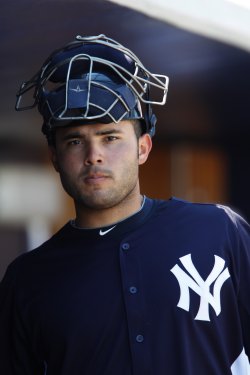
With Cervelli on the shelf to start the season, we can assume that Montero breaks camp as the backup catcher. That will give him a quick taste of the big leagues, affording him maybe three starts each week he’s with the club. Then, when Cervelli returns the team can re-assess. If Martin is playing well they can ship Montero back to AAA and use Cervelli as the backup, which is clearly his most useful role. If Martin isn’t hitting, perhaps they’ll keep Montero around and let him split time and learn at the major league level.
It’s hard for the Yankees to go wrong in this scenario. If Martin is hitting the Yankees have a valuable starter and backup combination. Cervelli can play once a week, which suits him well. If Martin isn’t hitting, the Yankees can put a greater emphasis on Montero, whose bat is, by all accounts, ready for the majors. Either way, the Yankees will likely realize well above average production from their catcher. That’s a good thing, since it’s what they’ve grown accustomed to in the past decade with Posada behind the plate.
It has been a while since the Yankees have broken camp with a high quality bench. They face issues every year in attracting free agent reserve players, since their full-time players don’t leave much room for additional playing time. But this past off-season they took time to build a strong and versatile bench. From the way things appear now, that effort should pay off handsomely. Even if it doesn’t, there’s still room for the Yankees to build the bench the way they did in 2009. There will always be players available around the deadline.
It’s (finally) official: Andruw Jones is a Yankee
At long last, the Yankees have officially announced that they have signed outfielder Andruw Jones. The two sides originally agreed to terms about four weeks ago, but for whatever reason the signing was delayed. Jones was issued number 18 and had a locker in the clubhouse today, so it was only a matter of time.
To make room on the 40-man roster, the Yankees have designated right-hander Brian Schlitter for assignment. They claimed him off waivers from the Cubs last month, but they have more pitchers in camp on minor league contracts than they know what to do with. Schlitter was nothing more than an up-and-down guy, so he drew the short straw. I’m surprised that Reegie Corona lived to see yet another day.
- « Previous Page
- 1
- …
- 4
- 5
- 6
- 7
- 8
- Next Page »
